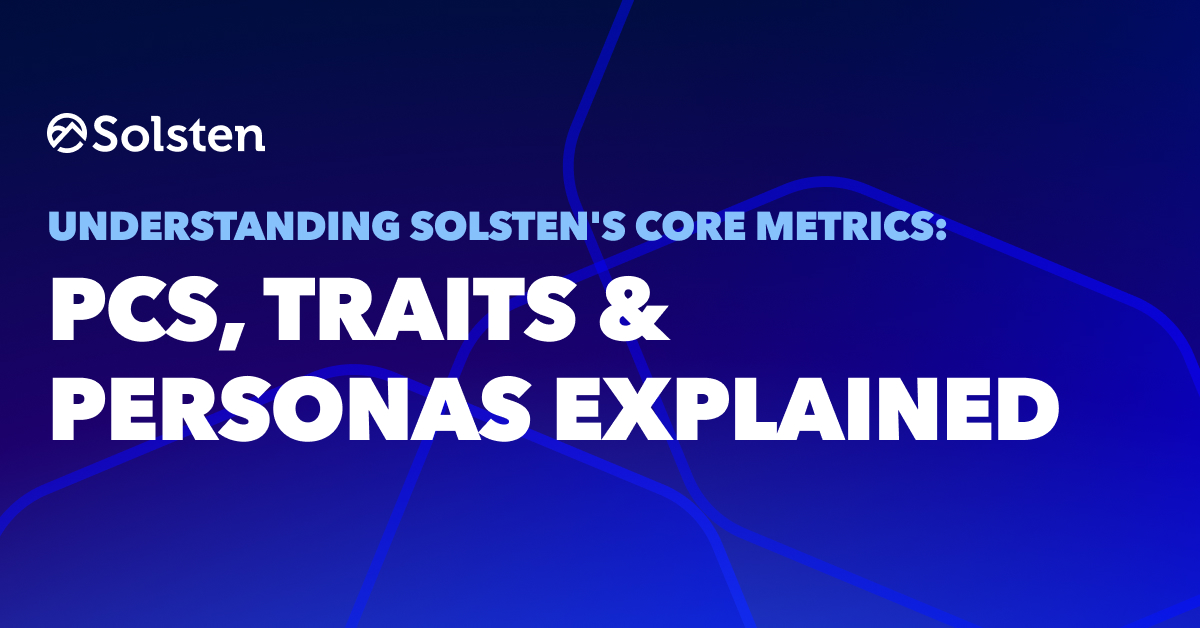Having a deep understanding of your audience is one of the most powerful ways to gain a competitive advantage in gaming. Whether you’re an indie developer or a AAA studio, the better you know your players, the better you can create experiences they will love and market to your most valuable audience.
To know your audience, you need data. And to compete in today’s market, that data needs to go beyond behavior and demographics. Solsten makes it easy for game developers to gain deep insights into player motivations, values, emotions, pain points, and beyond.
At the heart of Solsten’s methodology are three core metrics: The Player Centered Score (PCS), Traits, and Personas. This article will demystify these metrics, explaining what they are, how they’re calculated, and how you can use them to power your game development and marketing strategies.
The Player Centered Score (PCS): Measuring Game-Player Alignment
The Player Centered Score (PCS) is a proprietary metric that Solsten has pioneered. It measures how well a game aligns with a player’s psychological profile. Unlike traditional metrics that focus on player behavior, PCS goes deeper, examining the psychological fit between a game and its players.
PCS is calculated using an algorithm that considers multiple psychological factors, including personality traits, motivations, values, and preferences. The algorithm analyzes the psychological profile of a player or a group of players and compares it to the psychological elements present in a game. The result is a score that indicates the degree of alignment between the two.
Another way of thinking about PCS is that it measures resonance. The more a game resonates with its players, the higher the PCS will be.
Interpreting PCS is straightforward: a higher score indicates better alignment between the game and player psychology. For example, a PCS of 85 suggests that the game strongly resonates with the psychological profile of the player or player persona, while a score of 40 might indicate a significant mismatch.
There are lots practical applications for PCS. Game developers can use it to:
- Predict player engagement and retention
- Identify potential areas for improvement in game design
- Guide marketing efforts by targeting players with high psychological alignment
- Benchmark their game against competitors in terms of psychological appeal
By focusing on improving PCS, developers can create games that deeply resonate with their target audience, leading to higher engagement, better retention, and increased player satisfaction.
Traits: The Building Blocks of Player Psychology
Traits are core psychological characteristics that influence player behavior. If behavior data tells you what players have done, traits tell you what they will do. Thinking about it this way, its easy to see why traits have quickly become indispensable data points for some of the biggest names in gaming, including Activision, EA, Sony, and Supercell. These traits go beyond simple demographics, providing a deeply nuanced understanding of what drives players to engage with games.
Solsten measures a wide range of psychological traits, including:
- Personality Traits: Traits that describe the major dimensions of habitual behaviors, cognitions, and emotional patterns, including Altruism, Assertiveness, Impulsiveness, and Self-Discipline.
- Intrinsic Motivational Traits: These traits capture the driving forces that compel behavior, including Fearlessness, Independence, Purpose, and Status Orientation.
- Value-Based Traits: These reflect players’ core beliefs and what they consider important in life and in gaming experiences. Solsten measures dozens of values, including Creativity, Family, Leadership, and Recognition.
Each trait is scored on a scale from 0 to 100. A higher score indicates a stronger presence of that trait in the player or player persona. For example, a high score in “Achievement” means that the player is strongly motivated by accomplishing goals and making progress in games.
The implications of trait scores are significant for game design and marketing. Low scores in certain traits might indicate areas where the game is not meeting player needs, while high scores can highlight aspects of the game that are particularly appealing. For instance, if your player base scores high in Status Orientation, you might consider introducing status ranking elements based on both social voting and in-game accomplishments. To market to players like these, you might stress gaming experiences that include special performance rewards, public recognition, or special privileges and features that come with a certain status.
Understanding trait scores allows developers and marketers to:
- Tailor game mechanics to match player motivations
- Create more compelling narratives that resonate with player values
- Design reward systems that align with player preferences
- Write marketing messages that speak directly to player psychology
With traits data, developers can create more personalized and engaging gaming experiences that truly resonate with their audience.
Personas: Bringing Player Profiles to Life
Solsten’s personas represent psychologically likeminded groups of players. These are not just demographic sketches or archetypes, but scientifically-derived, psychologically-grounded representations of players within your game’s audience. These rich personas also have affinity data on favorite games, brands, media, and tech, and include data on estimated LTV.
Solsten’s AI builds personas by clustering players based on similarities in their psychological profiles. This process involves analyzing patterns in trait scores, motivations, and behaviors across the player base. The result is a set of distinct personas, each representing a segment of your audience with shared psychological characteristics. These personas are completely unique to your game and your audience.
The number of personas can vary depending on the makeup of your player base. Typically, games have anywhere from three to seven personas. The key is to have enough personas to represent significant variations in your audience without becoming overly complex.
Geographical distribution is incorporated into Solsten’s personas, giving developers insight into how psychological profiles might vary across different regions. This can be particularly valuable for games with a global audience, enabling region-specific tailoring of game features or marketing strategies.
Solsten’s personas are not static — they update over time as your player base evolves. Personas are refined based on new data so your understanding of your players remains current.
Practical applications of personas include:
- Guiding game design decisions to cater to different player types
- Informing content creation to appeal to various segments of your audience
- Tailoring marketing campaigns to resonate with specific player groups
- Personalizing in-game experiences based on player personas
By understanding and designing for these personas, developers can create games that appeal to a broader audience while still providing personalized experiences.
Putting It All Together
The true power of Solsten’s metrics lies in how they work together to provide a 360 view of your players. PCS gives you an overall measure of how well your game resonates with players psychologically. Traits provide the detailed building blocks of player psychology, allowing you to understand the specific elements that drive engagement. Personas bring these insights to life, creating actionable player profiles that can guide design and marketing decisions.
By integrating these metrics into your game development and marketing processes, you can:
- Design games that deeply resonate with your target audience
- Optimize marketing creative to psychologically appeal to specific audiences
- Improve player retention by aligning game experiences with player psychology
- Identify new market opportunities by understanding unmet psychological needs
- Identify new valuable audiences to bring into your experience
- Make data-driven decisions throughout the game development lifecycle
Solsten’s core metrics — PCS, Traits, and Personas — provide a powerful toolkit for understanding and engaging players on a deeper level. With these metrics, game developers can create more compelling, psychologically resonant games that stand out in an increasingly competitive market.
Mythical used Solsten to identify high LTV audiences among players with affinity for the NFL, and helped NFL Rivals debut at #1 in Google & Apple stores.


